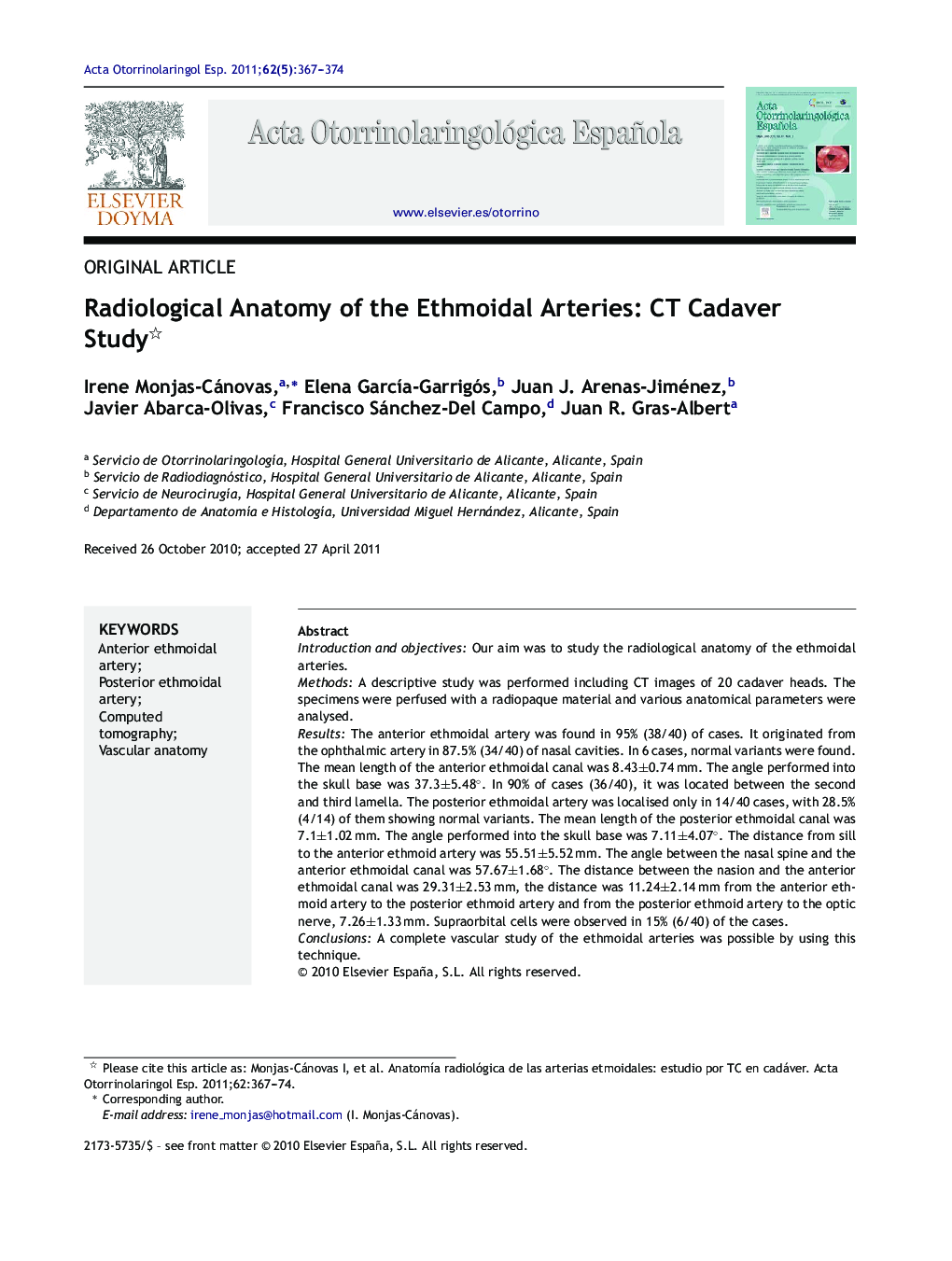| کد مقاله | کد نشریه | سال انتشار | مقاله انگلیسی | نسخه تمام متن |
|---|---|---|---|---|
| 4101187 | 1268750 | 2011 | 8 صفحه PDF | دانلود رایگان |

Introduction and objectivesOur aim was to study the radiological anatomy of the ethmoidal arteries.MethodsA descriptive study was performed including CT images of 20 cadaver heads. The specimens were perfused with a radiopaque material and various anatomical parameters were analysed.ResultsThe anterior ethmoidal artery was found in 95% (38/40) of cases. It originated from the ophthalmic artery in 87.5% (34/40) of nasal cavities. In 6 cases, normal variants were found. The mean length of the anterior ethmoidal canal was 8.43±0.74 mm. The angle performed into the skull base was 37.3±5.48°. In 90% of cases (36/40), it was located between the second and third lamella. The posterior ethmoidal artery was localised only in 14/40 cases, with 28.5% (4/14) of them showing normal variants. The mean length of the posterior ethmoidal canal was 7.1±1.02 mm. The angle performed into the skull base was 7.11±4.07°. The distance from sill to the anterior ethmoid artery was 55.51±5.52 mm. The angle between the nasal spine and the anterior ethmoidal canal was 57.67±1.68°. The distance between the nasion and the anterior ethmoidal canal was 29.31±2.53 mm, the distance was 11.24±2.14 mm from the anterior ethmoid artery to the posterior ethmoid artery and from the posterior ethmoid artery to the optic nerve, 7.26±1.33 mm. Supraorbital cells were observed in 15% (6/40) of the cases.ConclusionsA complete vascular study of the ethmoidal arteries was possible by using this technique.
ResumenIntroducción y objetivosEl objetivo del trabajo es realizar un estudio de la anatomía radiológica de las arterias etmoidales.MétodosSe realizó un estudio descriptivo con imágenes de tomografía computarizada correspondientes a 20 cabezas de cadáver perfundidas con material radiopaco. Se analizaron diferentes parámetros anatómicos.ResultadosLa arteria etmoidal anterior se localizó en el 95% (38/40) de los casos. En el 87,55% (35/40) de las fosas se originó de la arteria oftálmica, encontrando en seis casos variantes de la normalidad. La longitud media del canal etmoidal anterior fue de 8,43 ± 0,74 mm con un ángulo de entrada en la base de cráneo de 37,3 ± 5,48°. En el 90% de los casos (36/40), se localizó entre la segunda y la tercera lamela. La arteria etmoidal posterior sólo pudo localizarse en (14/40) fosas nasales. El 28,5% (4/14) presentaron variantes en su origen. La longitud media del canal etmoidal posterior fue de 7,1 ± 1,02 mm realizando un ángulo anterior a su salida de la órbita de 7,11 ± 4,07°. La distancia desde la espina nasal hasta la arteria etmoidal anterior fue de 55,51 ± 5,52 mm. El ángulo realizado entre la espina nasal y el canal etmoidal anterior fue de 57,67 ± 1,68°. La distancia entre el nasión y el canal etmoidal anterior fue de 29,31 ± 2,53 mm, de la arteria etmoidal anterior a la arteria etmoidal posterior fue de 11,24 ± 2,14 mm y de la arteria etmoidal posterior al nervio óptico de 7,26 ± 1,33 mm. Se apreciaron celdas supraorbitarias en el 15% (6/40) de las fosas.ConclusionesLa técnica utilizada permitió realizar un análisis vascular completo del trayecto de las arterias etmoidales.
Journal: Acta Otorrinolaringologica (English Edition) - Volume 62, Issue 5, September–October 2011, Pages 367–374